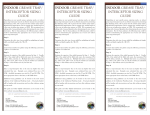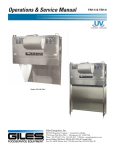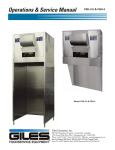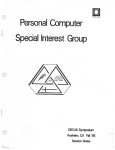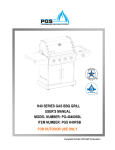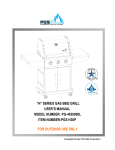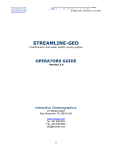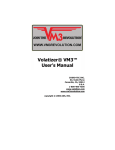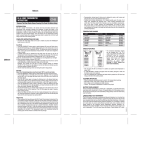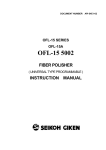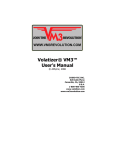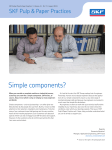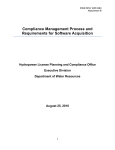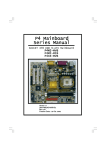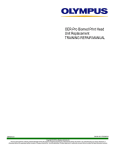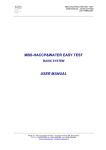Download Appendix 7.A - City of Lakeport
Transcript
City of Lakeport Municipal Sewer District FOG Program BMPs REASONING Check grease interceptor solids depth routinely. The combined thickness of the floating grease and the bottom solids should not be more than 25% of the total interceptor depth. Grease interceptors will not meet performance standards when solids and floating grease levels exceed 25%. Collect and recycle waste cooking oil. These actions reduce grease loading on grease removal devices and the sewer. “Dry wipe” pots, pans, and kitchen equipment before cleaning. “Dry wiping” will reduce the grease loading on grease removal devices and the sewer. Maintain a routine grease trap cleaning schedule. If grease traps are not routinely cleaned, they do not work properly and do not prevent grease from entering the sewer. If the grease trap is not providing adequate protection, a grease interceptor may be required. Use absorbent paper under fryer baskets. This reduces the amount of grease during cleanup. Use absorbents, such as paper towels and cat litter, to pick up oil and grease spills before mopping. Do not use emulsifiers or solvents other than typical dishwashing detergents. No hot water over 140°F Decreases the amount of grease that will be put down the drain. BENEFITS This will keep grease interceptor working at peak performance. This will reduce cleaning frequency and maintenance costs for grease removal devices and reduce the amount of grease entering the system. This will reduce cleaning frequency and maintenance costs for grease removal devices and reduce the amount of grease entering the drain. This reduces the amount of grease entering the drain and protects sewers from grease blockages and overflows. The amount of grease entering the drain is reduced, which protects the sewer system from grease blockages and overflows. Reduces the amount of grease entering the drain and protects sewers from grease blockages and overflows. Emulsifiers and solvents will break down grease causing a problem downstream in the sewer. Allows for proper removal of grease. Temperatures in excess of 140°F in any sink will dissolve grease and send it into the sewer. By reducing water temperature, you will save costs for heating that water, reduce the risk of clogging up your sewer lateral, and will save the cost of hiring someone to clean out your pipes. CITY OF LAKEPORT MUNICIPAL SEWER DISTRICT Over 100 years of community, pride, progress, and service. FATS, OILS AND GREASE (FOG) PROGRAM BEST MANAGEMENT PRACTICES (BMPs) FOR FOOD SERVICE ESTABLISHMENTS What is FOG and Why is it Important to My Business? INSIDE THIS GUIDE 1 2 Why is FOG Important? 3 Food Prep Spill Prevention 4 Maintenance 5 Simple Suggestions to Reduce FOG Oil and Grease Collection, Recycling and Food Donations 6 Grease Traps 7 Tips 8 BMP Summary “The best way to manage FOG is to keep fats, oils, and grease out of the sewer system.” Residual fats, oils, and grease (FOG) are by-products that food service establishments must constantly manage. Typically, FOG enters a facility’s plumbing system from ware washing, floor cleaning, and equipment sanitation. FOG will clog pipes and cause unsanitary spills or overflows to occur in food preparation areas, around a food service facility (e.g., in a parking lot or alleyway), or out on the street near a manhole or sewer access point. Spills and overflows are costly to clean up for businesses and the City, which means less profit for your restaurant, or other food service establishment, and possible fines and other penalties from the City. Sanitary sewer systems are neither designed nor equipped to handle the FOG that accumulates on the interior of the municipal sewer collection system pipes. The best way to manage FOG is to keep fats, oils and grease out of the sanitary sewer systems. Some Simple Suggestions to Reduce FOG Training Train kitchen staff and other employees about how they can help ensure BMPs are implemented. People are more willing to support an effort if they understand the basis for it. Through understanding, all subsequent BMPs will have a better chance of being implemented. FOG Program: Best Management Practices Page |2 Dry Clean-Up Practice dry clean-up. Remove food waste with “dry” methods such as scraping, wiping, or sweeping before using “wet” methods that use water. Wet methods typically wash the water and waste materials into the drains where it eventually collects on the interior walls of the drainage pipes. Do not pour grease, fats or oils from cooking down the drain and do not use the sink to dispose of food scraps. Likewise it is important to educate kitchen staff not to remove drain screens as this may allow paper or plastic cups, straws, and other utensils to enter the plumbing system during clean up. The success of dry clean-up is dependent upon the behavior of the employee and availability of the tools for removal of food waste before washing. To practice dry clean-up: “Do not pour grease, fats or oils from cooking down the drain and do not use the sink to dispose of food scraps.” • Use rubber scrapers to remove fats, oils and grease from cookware, utensils, chafing dishes, and serving ware. • Use food grade paper to soak up oil and grease under fryer baskets. • Use paper towels to wipe down work areas. Cloth towels will accumulate grease that will eventually end up in your drains from towel washing/rinsing. Signs Post “No Grease” signs above sinks and on the front of dishwashers. Signs are a constant reminder to kitchen staff that something must be observed, such as those for hand washing or fire danger. Signs will help minimize the amount of material going into grease traps/interceptors and will reduce the cost of cleaning and disposal. Water Temperature Keep water less than 140°F in all sinks, especially in any pre-rinse sink in line before a mechanical dishwasher. Temperatures in excess of 140°F in any sink will dissolve grease and send it into the sewer. However, that grease will cool and eventually solidify somewhere down the line in your sewer lateral or the municipal collection system. This will create sewer blockages elsewhere, leading to spills at your facility or overflows nearby. By reducing water temperature, you will save costs for heating that water, reduce the risk of clogging up your sewer lateral, and will save the cost of hiring someone to clean out your pipes. FOG Program: Best Management Practices Page |3 Food Prep Spill Prevention Preventing spills reduces the amount of waste on food preparation and serving areas that will require clean up. A dry workplace is safer for employees in avoiding slips, trips and falls. For spill prevention: “A dry workplace is safer for employees in avoiding slips, trips and falls.” • Empty containers before they are full. • Use a cover to transport grease interceptor contents to a rendering barrel. • Provide employees with the proper tools (ladles, ample containers, etc.) to transport materials without spilling. Maintenance Maintenance is key to avoiding FOG blockages. Grease traps, interceptors or other FOG capturing equipment should be regularly maintained. All staff should be aware of, and trained to perform, correct cleaning procedures, particularly for under-sink interceptors that are prone to malfunction due to improper maintenance. A regular maintenance schedule is highly recommended. More beneficial maintenance suggestions include: “Some facilities may require monthly cleaning of their grease traps or interceptors; others may need it less frequently.” • Contract with a management company to professionally clean large hood filters. Small hoods can be hand-cleaned with spray detergents and wiped down with cloths for cleaning. Hood filters can be effectively cleaned by routinely spraying with hot water with little or no detergents over the mop sink, which should be connected to a grease trap/interceptor. After a hot water rinse (separately trapped), filter panels can go into the dishwasher. For hoods to operate properly in the removal of greaseladen vapors, the ventilation system will also need to be balanced with sufficient make-up air. • Skim/Filter fryer grease daily and change oil when necessary. Use a test kit provided by your grocery distributor rather than simply a “guess” to determine when to change oil. This extends the life of both the fryer and the oil. Build-up of carbon deposits on the bottom of the fryer act as an insulator that forces the fryer to heat longer, causing the oil to break down sooner. FOG Program: Best Management Practices Page |4 • Collect fryer oil in an oil rendering tank for disposal or transport it to a bulk oil rendering tank instead of discharging it into a grease interceptor or waste drain. • Cleaning intervals depend upon the type of food establishment involved. Some facilities may require monthly cleaning of their grease traps or interceptors; others may need it less frequently. Establishments that operate a large number of fryers or handle a large amount of fried foods (such as chicken), along with ethnic food establishments, may need at least monthly cleanings. Full-cleaning of grease traps (removing all liquids and solids and scraping the walls) is a worthwhile investment. Remember, sugars, starches and other organics accumulate from the bottom up. If sediment is allowed to accumulate in the trap, it will need to be pumped more frequently. • Develop a rotation system if multiple fryers are in use. Designate a single fryer for products that are particularly high in deposits, and change that one more often. Oil and Grease Collection, Recycling and Food Donation Get paid to recycle your yellow grease. FOG, especially yellow grease, is a commodity that, if handled properly, should be treated as a valuable resource. Yellow grease, or ”tallow,” as it is sometimes referred to, is cooking grease. When heated and purified, it can be sold to soap, cosmetic, and animal feed companies. When handling your grease, consider the following: • Some rendering companies will offer services free-ofcharge and others will give a rebate on the materials collected. A list of registered grease haulers can be found in the Grease Rendering Guide or on the City’s web site, www.cityoflakeport.com. • Use 25-gallon rendering barrels with covers for onsite collection of oil and grease other than from fryers. Educate kitchen staff on the importance of keeping outside barrels covered at all times. During storms, uncovered or partially covered barrels allow storm water to enter the barrel resulting in oil running onto the ground and possibly into storm drains, and can contaminate an otherwise useful by-product. FOG Program: Best Management Practices “Edible food waste may be donated….It helps reduce disposal costs….” Page |5 • Use a 3-compartment sink for ware washing. Begin with a hot pre-wash, followed by a scouring sink with detergent, then a rinse sink. • Make sure all drain screens are installed. • Prior to washing and rinsing, use a hot water ONLY (no detergent) pre-rinse that is separately trapped to remove non-emulsified oils and greases from ware washing. Wash and rinse steps should also be trapped. • Empty grill top scrap baskets or scrap boxes and hoods into the rendering barrel. • Easy does it! Instruct staff to be conservative about their use of fats, oils and grease in food preparation and serving. • Ensure that edible food is not flushed down your drains. Edible food waste may be donated to a local food bank. Food donation is a win-win situation. It helps restaurants reduce disposal costs and it puts the food in the hands of those who can use it. Contact the Lake County Department of Social Services at 9954200 to learn more. Grease Traps/Interceptors The City’s new sewer use ordinance requires all businesses that produce FOG to install, operate, and maintain a grease trap or interceptor. Installing or upgrading a grease trap or grease interceptor is a beneficial investment for any food service establishment, given the costly effects of FOG. But before doing so, the following should be considered: • For grease traps to be effective, the unit(s) must be properly sized, constructed, and installed in a location to provide an adequate retention time for settling and accumulation of the FOG. If the unit(s) is too close to the FOG discharge and does not have enough volume to allow amassing of the FOG, the emulsified oils will pass through the unit without being captured. For information on properly locating, constructing, and sizing grease traps, contact the City’s Compliance Officer or visit the City’s web site at www.cityoflakeport.com. FOG Program: Best Management Practices Contact the City’s Compliance Officer at 263-5615 for more information. Page |6 • Ensure all grease-bearing drains discharge to the grease trap. These include mop sinks, woks, wash sinks, prep sinks, utility sinks, pulpers, dishwashers, prerinse sinks, can washes, and floor drains in food preparation areas such as those near a fryer or tilt/steam kettle. No toilet wastes should be plumbed to the grease trap. • If these suggested best management practices do not adequately reduce FOG levels, the operator may consider installing a second grease trap with flowthrough venting. This system should help reduce grease effluent substantially. Consumer Tip Buyer beware! When choosing a method of managing your fats, oil, and grease, ensure that it does what the vendor says it will do. Some technologies or “miracle cures” don’t eliminate the problem but result in grease accumulations further down the sewer line. “Out of sight” is not “out of mind.” Check the vendor’s references. Contact Information Please contact the City’s Compliance Officer at 263-5615, or by Email at [email protected], for more information or to discuss your particular FOG situation. We’re here to help you succeed! Mailing Address: Lakeport City Hall 225 Park Street Lakeport, CA 95453 FOG Program: Best Management Practices Page |7 SUMMARY BEST MANAGEMENT PRACTICES (BMPs) FOR FOOD RELATED FATS, OILS AND GREASE BMPs REASONING BENEFITS Train all staff on BMPs. People are more willing to support an effort if they understand the reasons behind it. Post “No Grease” signs above sinks and on the front of dishwashers. Check grease interceptor solids depth routinely. The combined thickness of the floating grease and the bottom solids should not be more than 25% of the total interceptor depth. Collect and recycle waste cooking oil. Signs serve as a constant reminder for staff working in kitchens. Trained staff will be more likely to implement BMPs and work to reduce grease discharges to the sewer. Reminders help minimize grease discharge to the sewer or grease removal device. This will keep grease interceptor working at peak performance. “Dry wipe” pots, pans, and kitchen equipment before cleaning. “Dry wiping” will reduce the grease loading on grease removal devices and the sewer. Maintain a routine grease trap cleaning schedule. If grease traps are not routinely cleaned, they do not work properly and do not prevent grease from entering the sewer. If the grease trap is not providing adequate protection, a grease interceptor may be required. This reduces the amount of grease during cleanup. Use absorbent paper under fryer baskets. Use absorbents, such as paper towels and cat litter, to pick up oil and grease spills before mopping. Do not use emulsifiers or solvents other than typical dishwashing detergents. Grease interceptors will not meet performance standards when solids and floating grease levels exceed 25%. These actions reduce grease loading on grease removal devices and the sewer. Decreases the amount of grease that will be put down the drain. Emulsifiers and solvents will break down grease causing a problem downstream in the sewer. This will reduce cleaning frequency and maintenance costs for grease removal devices and reduce the amount of grease entering the system. This will reduce cleaning frequency and maintenance costs for grease removal devices and reduce the amount of grease entering the drain. This reduces the amount of grease entering the drain and protects sewers from grease blockages and overflows. The amount of grease entering the drain is reduced, which protects the sewer system from grease blockages and overflows. Reduces the amount of grease entering the drain and protects sewers from grease blockages and overflows. Allows for proper removal of grease. CITY OF LAKEPORT MUNICIPAL SEWER DISTRICT Over 100 years of community, pride, progress, and service. FATS, OILS AND GREASE (FOG) PROGRAM FREQUENTLY ASKED QUESTIONS (FAQs) INSIDE THIS FAQ 1 2 3 4 5 6 7 8 9 Is grease a problem? What is a grease trap and how does it work? What is a grease interceptor? How do I clean my grease trap? Can you recommend a maintenance schedule? Do I need a grease trap? Is the grease trap I have adequate? Who inspects grease traps/interceptors? Who determines if I need a grease trap or interceptor? 10 What if I don’t install a grease trap? 11 How can I get in compliance? Is grease a problem? In the sewage collection and treatment business, the answer is an emphatic “YES!” Grease is singled out for special attention because of its poor solubility in water and its tendency to separate from the liquid solution. Large amounts of oil and grease in the wastewater cause trouble in collection system pipes. It decreases pipe capacity and, therefore, requires frequent cleaning and results in a shorter lifespan. Oil and grease also hamper effective treatment at the wastewater treatment plant. Problems caused by wastes from restaurants and other grease producing establishments have served as the basis for the City’s new sewer ordinance, which governs the discharge of materials into the sewer system. It is also why the installation of grease traps or interceptors has become mandatory. What is a grease trap and how does it work? A grease trap is a small reservoir built into the wastewater piping, a short distance from a grease producing area. Baffles in the reservoir retain the wastewater long enough for the grease to congeal and rise to the surface. The grease can then be removed and disposed of properly. A diagram of a typical grease trap is presented in Figure 1 below. FOG Program: FAQs Page |2 Figure 1 Grease trap maintenance is typically performed by maintenance staff or other employees. Grease interceptors are usually cleaned by grease haulers or recyclers. What is a grease interceptor? A grease interceptor is a vault with a minimum capacity of between 500 and 750 gallons, located on the exterior of the building. The capacity of the interceptor provides adequate residence time so that wastewater has time to cool, allowing the remaining grease not collected by the traps time to congeal and rise to the surface, where it accumulates until the interceptor is cleaned. Figure 2 illustrates a typical grease interceptor. Figure 2 FOG Program: FAQs Page |3 How do I clean my grease trap/interceptor? Refer to the “Grease Trap Maintenance Guide” for useful information about how to clean your grease trap. Grease trap maintenance is typically performed by maintenance staff or other employees of a restaurant or other food service establishment/facility. Please refer to the Grease Trap Maintenance Guide for more information on how to clean and maintain your grease trap. Grease interceptors are usually cleaned by grease haulers or recyclers. Several vendors operate in the Lakeport area, providing both cleaning (grease removal) and disposal services. Please refer to the Restaurant Oil and Grease Rendering Guide for more information or check the local phone book for grease removal services. Can you recommend a maintenance schedule? All grease interceptors should be cleaned at least once every 60 days. Some establishments will find it necessary to clean their traps more often than that. If you find that you have to clean it often (every month), you may want to consider installing a larger trap or interceptor. Be sure to record all of your maintenance activity on the Maintenance Log. A copy can be obtained from the City’s Utilities Department or from the Lake County Department of Environmental Health. Do I need a grease interceptor? The short answer is yes. Pursuant to City code, any establishment that introduces grease or oil into the drainage and sewage system in quantities large enough to cause line blockages or hinder sewage treatment is required to install a grease interceptor. However, the size and type of interceptor may vary. You can make money by recycling your used yellow (cooking) grease. Interceptors and grease traps are usually required for high volume restaurants (full menu establishments operating 16 hours/day and/or serving 500+ meals/day) and large commercial establishments, such as hotels, hospitals, factories, or school kitchens. However, even small volume (fast food or take-out restaurants with limited menus, minimum dishwashing, and/or minimal seating capacity) and medium volume establishments (full menu establishments operating 8-16 hours/day and/or serving 100-400 meals/day) can generate significant amounts of grease. In order to ensure that the sewer remains free of grease and fully functional, the City is requiring all establishments to install interceptors. FOG Program: FAQs Page |4 Is the grease trap/interceptor I have adequate? It depends. The number of drains or fixtures connected to the trap and the maintenance schedule dictate whether a trap is effective at preventing grease from entering the sanitary sewer system. The bottom line: if grease is clogging your lateral or the City main near your establishment, most likely your trap is inadequate. Please feel free to contact the City’s Compliance Officer at 263-5615 if you have concerns about your grease trap or would like to discuss your particular grease issue. The County’s Environmental Health Department will conduct an inspection of your grease trap/interceptor at least once a year during a regular health inspection. Who inspects grease traps/interceptors and what are the criteria for those inspections? The County’s Environmental Health Department will identify your grease trap/interceptor at least once a year during a regular health inspection. The City’s Compliance Officer is trained to inspect the unit(s), if needed. Inspections may be frequent depending on any identified issues or concerns related to FOG in the sanitary sewer that may be occurring in or around your facility. For additional information about grease trap/interceptor inspections, please call the City’s Compliance Officer at 263-5615, ext. 30 or by Email at [email protected]. Who determines if I need a grease trap or interceptor? Generally speaking, City Code requires every restaurant or other food service establishment that produces grease to install and maintain a grease trap/interceptor, unless a variance is requested. If a variance is requested, a variance study will be performed, which will examine the feasibility of installing a grease trap at a subject location. The Community Development/Utilities Director, otherwise known as the CLMSD Director, will make the determination as to whether a grease trap is required or if it is infeasible. FOG Program: FAQs Page |5 What if I don’t install a grease interceptor? City code requires any establishment that introduces grease or oil into the drainage and sewage system in quantities large enough to cause line blockages or hinder sewage treatment is required to install a grease interceptor. Failure to do so may result in remuneration and fines up to $25,000 or more. However, you may request a variance, if you feel your circumstance warrants consideration. There are fees associated with this request. Please contact the Compliance Officer for more information. How can I get in compliance? Great question! I like how you’re thinking. If your business does not have a grease interceptor, and you produce fats, oils and grease, you will need to request a grease trap/interceptor installation permit. Contact the City’s Community Development Department at 263-3056 for more information and to request an application. Contact the City’s Compliance Officer at 263-5615 for more information. If you have a grease trap or interceptor and believe that it may be ineffective at keeping FOG out of the sanitary sewer (i.e. needs frequent cleaning, backups occurring in kitchen, etc.), you may need to upgrade or replace your existing grease trap/interceptor. A grease trap/interceptor installation permit will be required for this as well. To assess your grease discharge practices and determine if your efforts to minimize FOG are adequate, complete a Food Service Assessment Checklist. Contact the City’s Compliance Officer at 2635615 to receive a copy or to discuss your particular grease trap or interceptor issue. Contact Information Please contact the City’s Compliance Officer at 263-5615, or by Email at [email protected], for more information or to discuss your particular FOG situation. We’re here to help you succeed! Mailing Address: Lakeport City Hall 225 Park Street Lakeport, CA 95453 (707) 263-5615 CITY OF LAKEPORT MUNICIPAL SEWER DISTRICT Over 100 years of community, pride, progress, and service. FATS, OILS AND GREASE (FOG) PROGRAM FOOD SERVICE ASSESSMENT CHECKLIST FOOD SERVICE ASSESSMENT CHECKLIST This checklist will help you as a manager /owner of a food services establishment/facility (FSE) identify sources of fats, oil and grease and how they are being managed. By completing this checklist, you will gain a better understanding of your current practices and if they are adequate to minimize FOG discharges to the City of Lakeport Municipal Sewer District (CLMSD). Improper FOG disposal can result in costly and unhealthy sewer overflows and backups directly into your facility. Please take a moment to review this checklist and discuss it with your Health Inspector during your next scheduled inspection. Your inspector can answer many questions you may have about FOG and grease disposal. For additional information, please contact the City’s Compliance Officer at 263-5615. General Food Service Establishment Information 1. Facility Name: 2. Facility Address: 3. Facility Owner/Manager: 4. Type of food service operation: 5. Responsible person/organization: 6. Hours of operation: 7. Number of meals served/day: 8. Number of seats: Fats, Oil and Grease Trap/Interceptor 1. Type (under the sink, in ground, mechanical): 2. Number of units: 3. Size (gallons): 4. Location: Date (MM/DD/YYY): FOG Program: Food Service Assessment Checklist Grease Trap/Interceptor Maintenance 1. Pump-out schedule (monthly, weekly, etc.) 2. Pump service provider: 3. Maintenance log available on-site? 4. Is grease trap/interceptor cleaning observed by management? 5. Does service include complete pumping/cleaning of the trap and sample box, not just removing the grease layer? 6. Is the vault refilled with clean water, not with water already filled out? 7. Are enzymes/bacteria used? If yes, vendor name? ____________________________________ Page |2 □ Yes □ Yes □ Yes □ □ □ No No No □ Yes □ No □ Yes □ No Kitchen Equipment/Devices Are the following kitchen devices plumbed to discharge to the grease trap/interceptor? 1. Dishwashers: □ Yes 2. Pot sinks, multi-compartment sinks, mop sinks, pre-rinse sinks: □ Yes 3. Floor drains: □ Yes 4. Food streamers: □ Yes 5. Food grinders/pulpers: □ Yes 6. Steam kettle(s): □ Yes 7. Can washer(s): □ Yes Comments: □ □ □ □ □ □ □ No No No No No No No Are the following cleaned or maintained periodically? Is the cleanup water discharged to the grease trap? If not, where is it discharged?____________________________________________________ 1. Exhaust hoods and filters: □ Yes □ No 2. Floor mats, floors and grill tops □ Yes □ No 3. Exterior of the grease traps/interceptors □ Yes □ No 4. Dumpsters/trash cans □ Yes □ No 5. Parking lots and sidewalks □ Yes □ No Comments: Dry Cleanup 1. Are serving wares, utensils or food preparation surfaces wiped before washing? 2. Do employees know not to allow FOG or food wastes into the drains? 3. Are employees provided the necessary training and tools (rubber scrapers, brooms, absorbent materials for spills) for dry cleanup? □ Yes □ No □ Yes □ No □ Yes □ No FOG Program: Food Service Assessment Checklist Spill Cleanup and Prevention 1. Are cleanup kits in visible and accessible areas? 2. Are employees provided with adequate conveyance methods/tools (ladles, containers with lids, etc.) to prevent oil and grease spills while transferring from inside the restaurant to the outside storage bin? 3. Is there a designated employee(s) to manage/monitor cleanup? Employee Awareness Training 1. Have employees received training in the Best Management Practices (BMPs) for handling oil and grease (i.e. spill prevention, dry cleanup, etc.)? 2. Are employees involved in keeping FOG out of the drains? 3. Are signs posted in key areas that remind staff to keep oils and grease out of the drains? 4. Are new employees trained on FOG BMPs and existing employees trained on a routine basis (e.g. quarterly, semi-annually, etc.)? Grease Disposal 1. Are the outside oil and grease storage bins kept covered? 2. Are the outside storage bins located away from storm drains and catch basins? 3. Are dumpsters and grease recycling bins cleaned and checked for leaks often? 4. Is there a spill prevention plan, and are materials available in the event of a spill? Grease Management Contractors 1. Does your hauler/renderer have the proper legal licenses and permits to handle the oil and grease waste? 2. Who do you contact when there is a problem? 3. Do you know where the waste grease is sent for final disposal? Page |3 □ Yes □ Yes □ No □ No □ Yes □ No □ Yes □ No □ Yes □ Yes □ No □ No □ Yes □ No □ Yes □ Yes □ No □ No □ Yes □ No □ Yes □ No □ Yes □ No □ Yes □ Yes □ No □ No For further information on proper management of oil and grease from your food service operations, contact the City’s Compliance Officer at (707) 263-5615. CITY OF LAKEPORT MUNICIPAL SEWER DISTRICT Over 100 years of community, pride, progress, and service. FATS, OILS AND GREASE (FOG) PROGRAM GREASE RENDERING GUIDE Grease Recycling INSIDE THIS GUIDE 1 Grease Recycling 2 Benefits of Rendering 3 4 Renderers and Other Maintenance Vendors Questions to Ask a Renderer While pre-treating wastewater through the use of grease traps, skimmers, separators, and process flow treatment systems can greatly reduce FOG buildup in the sanitary sewer, source reduction of oil and grease must be the first course of action. Through dry cleanup, the development of an efficient collection system, and a rendering program, wastewater problems can be avoided. Rendering companies or “grease recyclers” will accept oil, grease, and other animal byproducts (known as “yellow” or “tallow” grease), including deep fry fat and bones. In fact, they may even pay you to take it. Waste oil and grease is tested for pesticides and other contaminants. Material is placed in a settling tank to remove solids, heated in a vacuum to volatize impurities and is then sold to companies for use as animal feed additives, in soap production, oils, cosmetic and skin care products, and in composting. Benefits of Rendering There are many potential benefits of rendering or recycling your grease, including: 1. Cost Avoidance: The charge for pumping out a grease trap is considerably more than the service fee charged by a Renderer. With dry cleanup and other source reduction techniques, many restaurants are reducing their water consumption, sewer usage, and are saving money. Rendering also helps restaurants avoid discharge penalties and fines for sewer system overflows resulting from FOG. FOG Program: Grease Rendering Guide Page |2 2. Economic Incentives: Renderers’ service fees are low and often provided at no charge. In some cases, rendering companies are willing to pay for restaurant oil and grease. 3. Environmental Savings: Natural resources and energy are conserved through source reduction and recycling. FOG recycling keeps these materials from clogging municipal sewer lines, as well as using valuable landfill space, and diverts it to a useful purpose. 4. Compliance: The sewer use ordinance for the City of Lakeport “In some cases, rendering companies are willing to pay for restaurant oil and grease.” strictly limits the type and amount of waste discharge into the system. Penalties may be levied against food service establishments (FSEs) when higher concentrations of fats, oils and grease are determined to be originating from a particular location. Rendering prevents grease from reaching the sewer system and, in so doing, helps FSEs maintain compliance and avoid costly penalties and fines, which range from $50 for a minor violation to $25,000 or more. Renderers and Other Maintenance Vendors A list of a few registered grease haulers based in Lake County is as follows: Action Sanitary, Inc. P.O. Box 492 Lower Lake, CA 95457 (707) 994-5068 Roto-Rooter of Lake County P.O. Box 1340 Kelseyville, CA 95451 (707) 279-9461 The Following Companies Also Service Lake County Darling International Inc. 429 Amador St. San Francisco, CA 94124 (800) 473-4890 North State Rendering Company Inc. 15 Shippee Rd. Oroville, CA 95965 (530) 343-6076 Sacramento Rendering Co. 11350 Kiefer Blvd. Sacramento, CA 95830 (800) 339-6493 Yokayo Biofuels 150 Perry Street Ukiah, CA 95482 (707) 472-0900 FOG Program: Grease Rendering Guide Page |3 Choosing a Grease Renderer or Hauler When selecting a grease disposal vendor, be aware that services and prices may vary. Minimum services should include: Penalties and fines resulting from noncompliance of the City’s sewer use ordinance can range from $50 to $25,000 or more. 1. Complete pumping and cleaning of the interceptor and sample box, rather than just skimming the grease layer. 2. Deodorizing and thoroughly cleaning affected areas, as necessary. 3. Disposal/reclamation at an approved location. You and your hauler should agree on an adequate cleaning frequency to avoid blockage of the line. Questions to Ask a Renderer When looking for an oil and grease renderer, it is important to ask the right questions, which may include: 1. Do you provide collection containers? 2. Do you provide transportation? 3. Can I expect revenue for my material? If not, what’s your service fee? 4. What are your contamination? specifications? What constitutes 5. If there is a problem, who should I contact? Remember that fats, oils, and grease are commodities and should be treated as valuable resources that can and should be recycled whenever possible. Contact Information Please contact the City’s Compliance Officer at 263-5615, or by Email at [email protected], for more information or to discuss your particular FOG situation. We’re here to help you succeed! CITY OF LAKEPORT MUNICIPAL SEWER DISTRICT Over 100 years of community, pride, progress, and service. FATS, OILS AND GREASE (FOG) PROGRAM GREAE TRAP AND INTERCEPTOR MAINTENANCE GUIDE Introduction INSIDE THIS GUIDE 1 Introduction 2 Grease Trap Maintenance 3 Grease Interceptor Maintenance Grease trap maintenance is usually performed by maintenance staff, or other employees of a food service establishment. Grease interceptor maintenance, which is usually performed by permitted haulers or recyclers (see Grease Rendering Guide) consists of removing the entire volume (liquids and solids) from the grease interceptor and properly disposing of the material in accordance with all federal, state, and/or local laws. When performed properly, and at the appropriate frequency, grease interceptor and trap maintenance can greatly reduce the discharge of fats, oil and grease (FOG) into the wastewater collection system. The required maintenance frequency for grease interceptors and traps depends greatly on the amount of FOG a facility generates as well as any best management practices (BMPs) that your establishment implements to reduce the FOG discharged into the sanitary sewer system. In many cases, an establishment that implements BMPs will realize financial benefit through a reduction in their required grease interceptor and trap maintenance frequency. Refer to Best Management Practice for Food Service Establishments for examples of BMPs that your establishment should follow. WARNING! Do not use hot water, acids, caustics, solvents, or emulsifying agents when cleaning grease traps and interceptors. FOG Program: Grease Trap and Interceptor Maintenance Page |2 Grease Trap Maintenance Proper maintenance for any grease trap is essential to the trap functioning correctly and efficiently. The following are simple steps to cleaning your grease trap(s): Grease trap maintenance is typically performed by maintenance staff or other employees. 1. Bail out any water in the trap or interceptor to facilitate cleaning. The water should be discharged to the sanitary sewer system. 2. Remove baffles, if possible. 3. Dip the accumulated grease out of the interceptor and deposit in a watertight container. 4. Scrape the sides, the lid, and the baffles with a putty knife to remove as much of the grease as possible, and deposit the grease into a watertight container. 5. Contact a hauler or recycler for grease pick-up. 6. Replace the baffle and the lid. 7. Record the volume of grease removed on your Maintenance Log. FOG Program: Grease Trap and Interceptor Maintenance Page |3 Grease Interceptor Maintenance Grease interceptors, due to their size, will usually be cleaned by grease haulers or recyclers. Licensed septic haulers can also pump out grease interceptors and haul the waste to the treatment plant. The hauler must be registered with the State as a grease hauler. A proper maintenance procedure for a grease interceptor is outlined below: Grease interceptors are usually cleaned by grease haulers or recyclers. NOTE: Since your establishment is liable for the condition of your pretreatment devices, you or your representative (manager, supervisor, etc.) should witness all cleaning/maintenance activities to verify that the interceptor is being cleaned fully and properly maintained. 1. Contact a grease hauler or recycler for cleaning. See the Grease Rendering Guide for a list of qualified grease vendors. 2. Ensure that all flow is stopped to the interceptor by shutting the isolation valve in the inlet piping to the interceptor. 3. Remove the lid and bail out any water in the trap or interceptor to facilitate cleaning. The water should be discharged to the sanitary sewer system. 4. Remove baffles, if possible. 5. Dip the accumulated grease out of the interceptor and deposit in a watertight container. 6. Pump out the settled solids and then the remaining liquids. 7. Scrape the sides, the lid, and the baffles with a putty knife to remove as much of the grease as possible, and deposit the grease into a watertight container. 8. Replace the baffle and the lid. 9. Record the volume of grease removed on your Maintenance Log. City of Lakeport Municipal Sewer District Mark Brannigan, Director 225 Park Street Lakeport, CA 95453 (707) 263‐5615 Over 100 years of community, pride, progress and service. GREASE TRAP/INTERCEPTOR MAINTENANCE LOG INSTRUCTIONS: PLEASE HAVE YOUR GREASE HAULER, RECYCLER, MAINTENANCE/CLEANING CONTRACTOR OR EMPLOYEE COMPLETE THIS LOG EACH TIME YOUR GREASE TRAP AND/OR INTERCEPTOR IS CLEANED. THIS FORM MUST BE SHOWN TO THE COUNTY HEALTH INSPECTOR, IF REQUESTED. FOR ADDITIONAL COPIES OF THIS FORM, PLEASE CONTACT THE CITY’S COMPLIANCE OFFICER AT 263‐5615 Facility Name Address Telephone Service Company Address Telephone Grease Trap/Interceptor Maintenance/Service Log Type of Service: Date Recycling Hauling Number of Units Serviced Serviced By (Name of Individual) Gallons Pumped Grease Disposal Site Name and Address PLEASE RETAIN THIS COPY WITH YOUR RECORDS FOR NO FEWER THAN 3 YEARS Condition of Unit(s) Remarks/Comments How can we help? I feel so proud knowing my restaurant is doing its part to Whether you have questions about grease render- reduce FOG. ing or need help identifying the best place to install a grease trap, we’re here to offer assistance. Call to schedule an appointment to meet with the City’s Compliance Officer or call for a consultation FATS, OILS AND GREASE (FOG) over the phone. Please visit the City’s web site for more information. www.cityoflakeport.com PROGRAM The Benefits of Proper FOG Disposal Eliminating FOG discharge to the sanitary sewer system is a win-win situation for the City, businesses, and the community as a whole. Just a few of the benefits associated with this effort include: • Reduced operating costs • More sewer capacity so the City can grow to meet the needs of your business • Potential reimbursement for grease recycling • Avoidance of penalties or fines imposed for clogging municipal sewer lines • A cleaner environment for your patrons and the community to enjoy ...and so much more. CLMSD CITY OF LAKEPORT MUNICIPAL SEWER DISTRICT For answers to your FOG questions or to discuss your particular grease issue, please contact the City’s Compliance Officer for a one-on-one consultation over the phone, or contact the Community Development/Utilities Department to schedule an appointment. Compliance Officer (707) 263-5615, ext. 30 [email protected] Community Development/Utilities Department (707) 263-5615, ext. 25 CITY OF LAKEPORT MUNICIPAL SEWER DISTRICT Over 100 years of community pride, progress, and service. City Hall 225 Park Street Lakeport, CA 95453 (707) 263-5615 FOG AND YOUR BUSINESS So, you’ve got a grease problem…? Best Management Practices (BMPs) Looking for a grease hauler? Below are a few tips to avoid putting fats, oil, and grease into the sanitary sewer. Here are few local vendors who may be able to clean your grease interceptor and haul your grease away…. BMPs Check grease interceptor solids depth routinely. The combined thickness of the floating grease and the bottom solids should not be more than 25% of the total interceptor depth. Collect and recycle waste cooking oil. “Dry wipe” pots, pans, and kitchen equipment before cleaning. Are you noticing frequent or regular sink or toilet backups at your facility? Are you finding that you have to call the plumber more Maintain a routine grease trap cleaning schedule. often than usual? Have you noticed sewer backups near or around your facility during rainy periods? You may have a FOG prob- Use absorbent paper under fryer baskets. lem. The discharge of fats, oil and grease (or FOG) into the sanitary sewer is a concern for everyone in the community. FOG sticks to the inside of sewer pipes and, over time, that material can build up and create a blockage. A Use absorbents, such as paper towels and cat litter, to pick up oil and grease spills before mopping. into our waterways. Nasty! Reducing that discharge is one of our top priorities. Together we can do it! Action Sanitary, Inc. P.O. Box 492 Lower Lake, CA 95457 (707) 994-5068 This will reduce cleaning frequency and maintenance costs for grease removal devices and reduce the amount of grease entering the system. This will reduce cleaning frequency and maintenance costs for grease removal devices and reduce the amount of grease entering the drain. This reduces the amount of grease entering the drain and protects sewers from grease blockages and overflows. The amount of grease entering the drain is reduced, which protects the sewer system from grease blockages and overflows. Reduces the amount of grease entering the drain and protects sewers from grease blockages and overflows. Roto-Rooter of Lake County P.O. Box 1340 Kelseyville, CA 95451 (707) 279-9461 Allows for proper removal of grease. No hot water over 140°F By reducing water temperature, you will save costs for heating that water, reduce the risk of clogging up your sewer lateral, and will save the cost of hiring someone to clean out your pipes. system overflow (SSO), which will release un- BUSINESS NAME This will keep grease interceptor working at peak performance. Do not use emulsifiers or solvents other than typical dishwashing detergents. blockage such as this can result in a sewer treated wastewater onto our properties and BENEFITS Darling International Inc. 429 Amador St. San Francisco, CA 94124 (800) 473-4890 North State Rendering Company Inc. 15 Shippee Rd. Oroville, CA 95965 (530) 343-6076 Sacramento Rendering Co. 11350 Kiefer Blvd. Sacramento, CA 95830 (800) 339-6493 Yokayo Biofuels 150 Perry Street Ukiah, CA 95482 (707) 472-0900 City of Lakeport Municipal Sewer District Fats, Oils and Grease (FOG) Program INDOOR GREASE TRAP/ INTERCEPTOR SIZING GUIDE INDOOR GREASE TRAP/ INTERCEPTOR SIZING GUIDE INDOOR GREASE TRAP/ INTERCEPTOR SIZING GUIDE Depending on your specific grease capturing needs, an indoor grease trap/interceptor may be an effective measure for preventing the discharge of fats, oils or grease into the sanitary sewer system. Manufactured interceptors come in varying sizes, usually based on a flow rate of gallons per minute, or GPM. We recommend consulting with a licensed plumber when determining the size of your interceptor. But for basic guidance, the following steps could be useful in determining the appropriate size of your new indoor grease trap/interceptor: Depending on your specific grease capturing needs, an indoor grease trap/interceptor may be an effective measure for preventing the discharge of fats, oils or grease into the sanitary sewer system. Manufactured interceptors come in varying sizes, usually based on a flow rate of gallons per minute, or GPM. We recommend consulting with a licensed plumber when determining the size of your interceptor. But for basic guidance, the following steps could be useful in determining the appropriate size of your new indoor grease trap/interceptor: Depending on your specific grease capturing needs, an indoor grease trap/interceptor may be an effective measure for preventing the discharge of fats, oils or grease into the sanitary sewer system. Manufactured interceptors come in varying sizes, usually based on a flow rate of gallons per minute, or GPM. We recommend consulting with a licensed plumber when determining the size of your interceptor. But for basic guidance, the following steps could be useful in determining the appropriate size of your new indoor grease trap/interceptor: Step 1: Step 1: Step 1: Determine the cubic size of your sink(s) by multiplying its length, width, and depth together (L x W x D). Determine the cubic size of your sink(s) by multiplying its length, width, and depth together (L x W x D). Determine the cubic size of your sink(s) by multiplying its length, width, and depth together (L x W x D). Step 2: Step 2: Step 2: Convert that number into gallons using the following conversion: 1 gallon = 231 cubic feet. Convert that number into gallons using the following conversion: 1 gallon = 231 cubic feet. Convert that number into gallons using the following conversion: 1 gallon = 231 cubic feet. Step 3: Step 3: Step 3: Estimate the capacity of the sink(s) measured in Step 1. Usually, 75% of the sink(s) will be filled with water, the remaining 25% will be dishes, utensils, etc. Multiply that factor as a percentage (e.g. 75% = 0.75, 25% = 0.25, etc.) by the number you calculated in Step 2. This will also serve as your flow rate. Estimate the capacity of the sink(s) measured in Step 1. Usually, 75% of the sink(s) will be filled with water, the remaining 25% will be dishes, utensils, etc. Multiply that factor as a percentage (e.g. 75% = 0.75, 25% = 0.25, etc.) by the number you calculated in Step 2. This will also serve as your flow rate. Estimate the capacity of the sink(s) measured in Step 1. Usually, 75% of the sink(s) will be filled with water, the remaining 25% will be dishes, utensils, etc. Multiply that factor as a percentage (e.g. 75% = 0.75, 25% = 0.25, etc.) by the number you calculated in Step 2. This will also serve as your flow rate. Step 4: Step 4: Step 4: Select a trap/interceptor that is the next size higher than your Select a trap/interceptor that is the next size higher than your Select a trap/interceptor that is the next size higher than your calculated flow rate. Example: your calculated flow rate is 78 calculated flow rate. Example: your calculated flow rate is 78 calculated flow rate. Example: your calculated flow rate is 78 GPM. Available interceptors are sized for 70 and 80 GPM. The GPM. Available interceptors are sized for 70 and 80 GPM. The GPM. Available interceptors are sized for 70 and 80 GPM. The most appropriate choice is the latter, an 80 GMP device. most appropriate choice is the latter, an 80 GMP device. most appropriate choice is the latter, an 80 GMP device. Additional sizing guidelines can be found in the most recent Additional sizing guidelines can be found in the most recent Additional sizing guidelines can be found in the most recent addition of the California Plumbing Code. A licensed plumber addition of the California Plumbing Code. A licensed plumber addition of the California Plumbing Code. A licensed plumber will be familiar with its provisions and can offer solutions unique will be familiar with its provisions and can offer solutions unique will be familiar with its provisions and can offer solutions unique to your needs. to your needs. to your needs. This guide and other helpful information can be found on the This guide and other helpful information can be found on the This guide and other helpful information can be found on the City’s website: www.cityoflakeport.com. City’s website: www.cityoflakeport.com. City’s website: www.cityoflakeport.com. CITY OF LAKEPORT MUNICIPAL SEWER DISTRICT CITY OF LAKEPORT MUNICIPAL SEWER DISTRICT CITY OF LAKEPORT MUNICIPAL SEWER DISTRICT Over 100 years of community pride, progress, and service. Over 100 years of community pride, progress, and service. Over 100 years of community pride, progress, and service. City Hall 225 Park Street Lakeport, CA 95453 City Hall 225 Park Street Lakeport, CA 95453 City Hall 225 Park Street Lakeport, CA 95453 Phone: 707-263-5615, ext. 30 E-mail: [email protected] Phone: 707-263-5615, ext. 30 E-mail: [email protected] Phone: 707-263-5615, ext. 30 E-mail: [email protected] OUTDOOR GREASE INTERCEPTOR SIZING GUIDE OUTDOOR GREASE INTERCEPTOR SIZING GUIDE OUTDOOR GREASE INTERCEPTOR SIZING GUIDE Outdoor, in-ground or above-ground grease interceptors are ideal for restaurants and other food service facilities that produce large amounts of fats, oil, and grease during food preparation. City Code allows for the use of two methods when sizing an outdoor interceptor. The first is based on criteria defined in the California Plumbing Code. A licensed plumber can provide excellent interceptor solutions to meet your needs based on this method. The second is the application of the Manning Formula, which is described here in greater detail: Outdoor, in-ground or above-ground grease interceptors are ideal for restaurants and other food service facilities that produce large amounts of fats, oil, and grease during food preparation. City Code allows for the use of two methods when sizing an outdoor interceptor. The first is based on criteria defined in the California Plumbing Code. A licensed plumber can provide excellent interceptor solutions to meet your needs based on this method. The second is the application of the Manning Formula, which is described here in greater detail: Outdoor, in-ground or above-ground grease interceptors are ideal for restaurants and other food service facilities that produce large amounts of fats, oil, and grease during food preparation. City Code allows for the use of two methods when sizing an outdoor interceptor. The first is based on criteria defined in the California Plumbing Code. A licensed plumber can provide excellent interceptor solutions to meet your needs based on this method. The second is the application of the Manning Formula, which is described here in greater detail: The Manning Formula: The Manning Formula: The Manning Formula: Interceptor Size (in gallons) = Flow rate (GPM)/sink or fixture x sum of fixture Ratings + the Discharge rate from any mechanical washers (i.e. dishwashers, glass washers, laundry machines, etc.) x a 24 minute retention Time. Interceptor Size (in gallons) = Flow rate (GPM)/sink or fixture x sum of fixture Ratings + the Discharge rate from any mechanical washers (i.e. dishwashers, glass washers, laundry machines, etc.) x a 24 minute retention Time. Interceptor Size (in gallons) = Flow rate (GPM)/sink or fixture x sum of fixture Ratings + the Discharge rate from any mechanical washers (i.e. dishwashers, glass washers, laundry machines, etc.) x a 24 minute retention Time. Flow Rates 0.5” pipe = 0.8 GPM/fixture 1.0 “ = 5.0 GPM/fixture 1.5 “ = 15 GPM/fixture 2.0” = 33 GPM/fixture 2.5” = 59 GPM/fixture 3.0” = 93 GPM/fixture Fixture Ratings 2,3, or 4 compartment sink = 1.0 1 or 2 compartment meat prep sink = 0.75 Pre-rinse sink = 0.5 1 or 2 compartment vegetable prep sink = 0.25 Can wash = 0.25 Mop sink = 0.25 Floor drain = 0.00 Flow Rates 0.5” pipe = 0.8 GPM/fixture 1.0 “ = 5.0 GPM/fixture 1.5 “ = 15 GPM/fixture 2.0” = 33 GPM/fixture 2.5” = 59 GPM/fixture 3.0” = 93 GPM/fixture Fixture Ratings 2,3, or 4 compartment sink = 1.0 1 or 2 compartment meat prep sink = 0.75 Pre-rinse sink = 0.5 1 or 2 compartment vegetable prep sink = 0.25 Can wash = 0.25 Mop sink = 0.25 Floor drain = 0.00 Flow Rates 0.5” pipe = 0.8 GPM/fixture 1.0 “ = 5.0 GPM/fixture 1.5 “ = 15 GPM/fixture 2.0” = 33 GPM/fixture 2.5” = 59 GPM/fixture 3.0” = 93 GPM/fixture Fixture Ratings 2,3, or 4 compartment sink = 1.0 1 or 2 compartment meat prep sink = 0.75 Pre-rinse sink = 0.5 1 or 2 compartment vegetable prep sink = 0.25 Can wash = 0.25 Mop sink = 0.25 Floor drain = 0.00 Using the charts above, you can calculate the size of the interceptor you need. Just plug them into the Manning Formula: Using the charts above, you can calculate the size of the interceptor you need. Just plug them into the Manning Formula: Using the charts above, you can calculate the size of the interceptor you need. Just plug them into the Manning Formula: Interceptor Size = [[(Flow Rate) x (Fixture Ratings)] + Discharge Rate] x 24 minute retention time Interceptor Size = [[(Flow Rate) x (Fixture Ratings)] + Discharge Rate] x 24 minute retention time Interceptor Size = [[(Flow Rate) x (Fixture Ratings)] + Discharge Rate] x 24 minute retention time Direct flow from dishwashers, laundry washers, glass washers, etc. is the discharge rate as determined by the manufacturer. This information should be available in your user’s manual or by contacting the manufacturer directly. Direct flow from dishwashers, laundry washers, glass washers, etc. is the discharge rate as determined by the manufacturer. This information should be available in your user’s manual or by contacting the manufacturer directly. Direct flow from dishwashers, laundry washers, glass washers, etc. is the discharge rate as determined by the manufacturer. This information should be available in your user’s manual or by contacting the manufacturer directly. 24 minute retention time is the minimum amount of time needed for grease to cool, condense, and separate from liquid. It is a constant for the purposes of this calculation. 24 minute retention time is the minimum amount of time needed for grease to cool, condense, and separate from liquid. It is a constant for the purposes of this calculation. 24 minute retention time is the minimum amount of time needed for grease to cool, condense, and separate from liquid. It is a constant for the purposes of this calculation. This guide and other helpful information (including calculation examples) can be found on the City’s website: www.cityoflakeport.com. This guide and other helpful information (including calculation examples) can be found on the City’s website: www.cityoflakeport.com. This guide and other helpful information (including calculation examples) can be found on the City’s website: www.cityoflakeport.com.






























